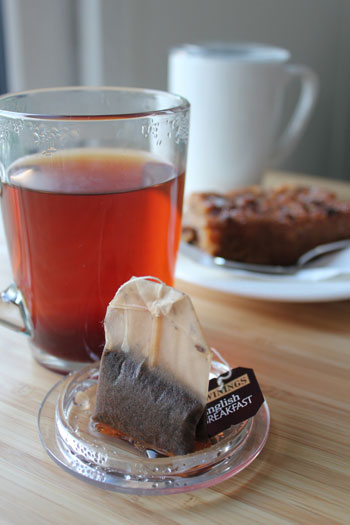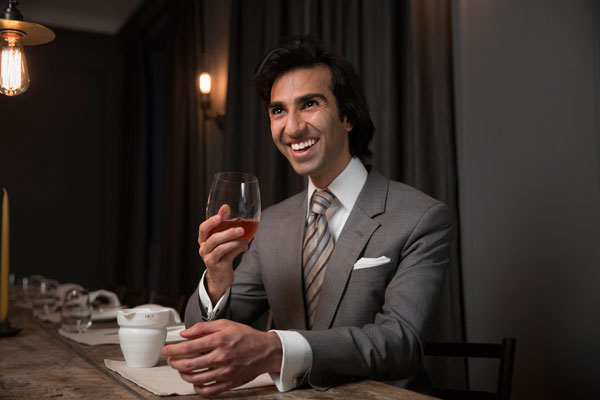Brews of the world: the success story of premium tea
The humble cuppa has come a long way in recent years, with premium tea consumption at an all-time high. Will Hawkes reports
Asparagus is one of those foods that keeps sommeliers awake at night. It's notoriously difficult to pair wine with asparagus, but there is one terroir that produces the perfect match: Nishi Garden in Kagoshima, Japan. But this part of Japan doesn't grow grapes, it grows green tea: Okumidori Kabusecha, to be precise.
"Tea and asparagus is a classic pairing," says Jameel Lalani, founder and owner of single-batch tea merchants Lalani & Co. The Kabusecha (‘shade-grown') is on the menu at Thomas's Cafe at Burberry in Vigo Street in London, alongside a dish of asparagus and poached egg. "The vegetals and the umami in the asparagus match what's in the tea," he says. "We're so used to drinking tea with sweet food, but actually in the whole spectrum of tea, there are a lot more matches for savoury foods."
It's a long way from the humble British cuppa, but tea is changing in the UK. According to a survey commissioned by food wholesaler Bidfood, 53% of consumers are now willing to spend more on a premium tea experience, while research by Tetley reveals that there has been a 3.6% year-on-year rise in out of home tea consumption.
"The mainstream media sometimes throw around the statistic that tea consumption is decreasing, but this doesn't tell the story of the tea revolution taking place in the UK," says Marco Geraghty of National Tea Day. "Tea consumption isn't decreasing; it's changing. Our research is telling us that younger consumers in particular aren't drinking six cups of tea with milk and two sugars before they leave the house, but instead opting for fewer cups of premium tea instead."
Tea terroir
For Lalani, tea's next revolution will happen in restaurants, not cafés. "Tea is the other terroir drink," he says. "It is the only other drink that has the same history, provenance and seasonality that wine does - and the ability to match with food. It's what people are looking for, what the dining industry is hoping to find. We got a lot of emails from people who don't drink or who are cutting back. There's a gap - what do you sell to people who are non-drinkers?"
The other five teas, though, are £5-£6 each, making them affordable for customers and retailers alike. "It's not an expensive luxury," says Lalani. "Your cost per serving for a very fine tea is going to be between 15p and £2.50, with most under £1.20. You can have the most beautiful Darjeelings from gardens 6,000 feet above sea level, or shade-grown Japanese green tea from an organic garden - the best teas from the region - and the cost per serving is low. Compared with wine or whisky, people can access the very best tea."
One of the big successes of recent years has been matcha, a Japanese green tea where the leaves are dried and then ground to make a powder. Lalani & Co has been importing high-quality matcha for the past four years. "We weren't sure it was going to sell - now we're shipping it very frequently," says Lalani. "It's important to remember that it's a tea, not an ingredient. It has flavour notes, producers; that message has been lost. A lot of the matcha that comes into the UK is cooking matcha, they expect it at a low price and that's the end of it."
An interest in better-quality tea is happening across the market. Taylors of Harrogate has seen a big increase in demand for speciality tea, according to out of home manager Natalie Cross. "We're seeing strong category growth in fruit and herbal, green and speciality black teas and are continuing to seek out new and different flavours for our product range to meet the demands of adventurous consumers wishing to expand their tea-drinking repertoires," she says.
The trend-makers
Much of the interest in quality tea is thanks to the efforts of one company: Teapigs. Launched in November 2006, Teapigs' focus on whole-leaf tea and pyramid-shaped bags was revolutionary. Investment from Tetley, the company the founders had worked for previously, helped them break into a market which, in the words of co-founder Nick Kilby, "was an old-fashioned, gentleman's world".
"Back in 2006, there was a food revolution going on, but not in tea," says Kilby, whose company turned over £12m last year. "But tea has huge diversity and authenticity; Teapigs was about wanting to change the face of the tea industry, to have a bit more fun. We wanted people to have access to better quality tea.
"We wanted people to think more about tea - it's not just a cuppa. There's a lot more to it than that, how you can prepare it. We wanted people to get more involved.
Kilby and business partner Louise Cheadle were inspired partly by what was happening in coffee, he says. "When we launched, the coffee revolution had already happened," he says. "It was good for us because we could go to these new coffee shops and say, 'You have great coffee, but what about tea? You have a lot of customers who would choose tea, given the choice.'
"What pleases us is that now, on menus in coffee bars, gastropubs and restaurants, there will be more of a tea menu. It doesn't just say 'tea'. Out of home it's still the poor relation to coffee, but tea has certainly caught on, with a younger age group too - 10 to 15 years ago you'd associate it with grannies. Nowadays tea is up there. And some people are over coffee and they want something lighter and healthier, like matcha."
This new younger drinker is behind the demand for better quality and variety, according to Twinings' shopper marketing manager Andrea Stopher. They're also more interested in their health. "They are increasingly savvy about calorie content and healthy ingredients," she says. "Health and wellbeing is still a driving trend out of home, which continues to influence consumer food and drink choices. One in five consumers intend to increase their tea consumption as part of a healthy lifestyle."
Marshall Kingston, Tetley senior brand manager, out of home, agrees. "Health remains a current key trend: consumers, in particular millennials, are creating an increasingly health-conscious generation. Tea is often chosen for its health and thirst-quenching benefits: green and fruit and herbal blends are growing by 5.6% and 2.5% respectively, and by promoting their health benefits to the under-45s, operators can tap into the current market trend and continue to drive sales."
Is tea healthy? "It's fair to say that it's a healthier drink than its rivals," say Lalani, "but I'm always cautious to make great claims. There is heavy evidence to support tea, but there are still only a few studies that have been conclusive. Without a doubt, though, it's full of antioxidants and it has no calories."
The proper kit
Coffee has seen a huge rise in the equipment an aficionado can buy, from the Aeropress to the Nespresso machine. Tea is a simpler drink to make, but there are still ways in which the experience can be improved, according to entrepreneur and inventor Roland Hill. Hill has come up with Teapy, a tea-making and serving mug that, he says, eliminates the most common problems with tea serving.












